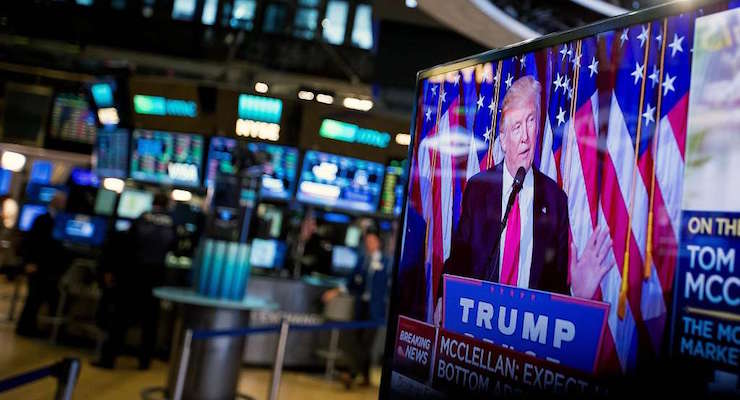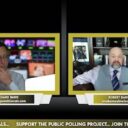

U.S. President-elect Donald Trump is seen speaking on a television on the floor of the New York Stock Exchange (NYSE) in New York, U.S., on Wednesday, Nov. 9, 2016. U.S. stocks fluctuated in volatile trading in the aftermath of Trump’s surprise presidential election win, as speculation the Republican will pursue business-friendly policies offset some of the broader uncertainty surrounding his ascent. Photographer: Michael Nagle/Bloomberg
The Dow Jones Industrial Average (INDEXDJX:.DJI) ended a 12-day winning streak as U.S. markets await President Donald J. Trump’s address to a joint session of Congress. The Dow, after consecutively closing at record highs, was down 25.20 (-0.12%) to 20,812.24.
The run matched the longest streak in January of 1987, 10 months before the Black Monday stock-market collapse in October of the same year. Still, the Dow has added more than 2500 points since the U.S. president election in November, which translates into roughly $3 trillion in wealth creation. On Nov. 22, 2016, the Dow breached 19,000 for the first time in history and, subsequently, it closed above the historical range for the first time ever.
Despite the same dire predictions the British heard before the Brexit vote, traders in U.S. markets ended their best 5-day period since 2011 on Jan. 6. It topped 20,000 and closed above it for the first time ever in U.S. history on Jan. 25.
Last week, Dow Chemical (NYSE:DOW) CEO Andrew Liveris said that the Trump administration is “probably the most pro-business administration since the founding fathers.” His comments came after attending a meeting with President Donald J. Trump, who hosted manufacturing leaders at the White House. The president has met with business leaders 11 times since taking office.
Now, investors are awaiting more clarity on policy President Trump promised to implement on the campaign trail. Since taking office, he has met some one dozen times with business leaders and signed two rounds of executive orders (here and here) aiming to significantly scale back regulation on small and large businesses.
On tax reform, President Trump proposed to reduce the corporate tax rate to 15%. However, House Speaker Paul Ryan, R-Wis., indicated congressional Republicans are willing to go to 20%, but would need additional spending cuts to offset any further rate reduction.
“We would love 20%, we’d love 15% even more,” Mr. Liveris said.
Worth noting, Wall Street digested data from the economic calendar Tuesday that was mixed and, at the least, could’ve given pause to traders wanting more timeline-specific details. The second reading of fourth quarter (4Q) gross domestic product (GDP) released by the Commerce Department found the U.S. economy grew at an abysmal 1.9% annual rate in the 4Q and just 1.6% for all of 2016. The latter was the worst GDP performance since 2011.
[social-media-buttons]
The final year of economic growth under the Obama presidency offset positive, more current data from the Institute for Supply Management on the manufacturing and home prices in the housing market.
The S&P CoreLogic Case-Shiller National Home Price Index covering all 9 U.S. census divisions rose 5.8% in the 12 months ended in December, setting a new 30-month high. The MNI Chicago Business Barometer rose by 7.1 points to 57.4 in February from 50.3 in January, the highest reading since January 2015.
The boom in the Barometer, also known as the Chicago PMI, came after Midwest Manufacturing activity fell 3.6 points to 50.3 in January “due to seasonal factors” from a previously revised 53.9 in December 2016.
The president will deliver what is his first address to a joint session of Congress Tuesday night at 9 p.m. ET.
[social-media-buttons]








Ajay Sharma / March 2, 2017
https://www.youtube.com/watch?v=czuXAtR1wZI
/